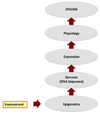Epigenetic transgenerational actions of environmental factors in disease etiology
- PMID: 20074974
- PMCID: PMC2848884
- DOI: 10.1016/j.tem.2009.12.007
Epigenetic transgenerational actions of environmental factors in disease etiology
Abstract
The ability of environmental factors to promote a phenotype or disease state not only in the individual exposed but also in subsequent progeny for successive generations is termed transgenerational inheritance. The majority of environmental factors such as nutrition or toxicants such as endocrine disruptors do not promote genetic mutations or alterations in DNA sequence. However, these factors do have the capacity to alter the epigenome. Epimutations in the germline that become permanently programmed can allow transmission of epigenetic transgenerational phenotypes. This review provides an overview of the epigenetics and biology of how environmental factors can promote transgenerational phenotypes and disease.
Copyright 2010 Elsevier Ltd. All rights reserved.
Figures


Similar articles
-
Epigenetic transgenerational actions of endocrine disruptors.Reprod Toxicol. 2011 Apr;31(3):337-43. doi: 10.1016/j.reprotox.2010.10.012. Epub 2010 Nov 3. Reprod Toxicol. 2011. PMID: 21055462 Free PMC article.
-
Endocrine disruptors and epigenetic transgenerational disease etiology.Pediatr Res. 2007 May;61(5 Pt 2):48R-50R. doi: 10.1203/pdr.0b013e3180457671. Pediatr Res. 2007. PMID: 17413841 Free PMC article.
-
Endocrine disruptor induction of epigenetic transgenerational inheritance of disease.Mol Cell Endocrinol. 2014 Dec;398(1-2):4-12. doi: 10.1016/j.mce.2014.07.019. Epub 2014 Jul 31. Mol Cell Endocrinol. 2014. PMID: 25088466 Free PMC article. Review.
-
Environmentally induced epigenetic transgenerational inheritance of phenotype and disease.Mol Cell Endocrinol. 2012 May 6;354(1-2):3-8. doi: 10.1016/j.mce.2011.10.004. Epub 2011 Oct 13. Mol Cell Endocrinol. 2012. PMID: 22020198 Free PMC article. Review.
-
Environmental signals and transgenerational epigenetics.Epigenomics. 2009 Oct;1(1):111-117. doi: 10.2217/epi.09.11. Epigenomics. 2009. PMID: 20563319 Free PMC article.
Cited by
-
Perinatal nicotine exposure induces asthma in second generation offspring.BMC Med. 2012 Oct 30;10:129. doi: 10.1186/1741-7015-10-129. BMC Med. 2012. PMID: 23106849 Free PMC article.
-
The impact of early-life environment on absence epilepsy and neuropsychiatric comorbidities.IBRO Neurosci Rep. 2022 Nov 9;13:436-468. doi: 10.1016/j.ibneur.2022.10.012. eCollection 2022 Dec. IBRO Neurosci Rep. 2022. PMID: 36386598 Free PMC article. Review.
-
Environmental epigenetics and phytoestrogen/phytochemical exposures.J Steroid Biochem Mol Biol. 2014 Jan;139:270-6. doi: 10.1016/j.jsbmb.2012.12.011. Epub 2012 Dec 27. J Steroid Biochem Mol Biol. 2014. PMID: 23274117 Free PMC article. Review.
-
Histone H3 lysine 4 methylation signature associated with human undernutrition.Proc Natl Acad Sci U S A. 2018 Nov 27;115(48):E11264-E11273. doi: 10.1073/pnas.1722125115. Epub 2018 Nov 12. Proc Natl Acad Sci U S A. 2018. PMID: 30420518 Free PMC article.
-
Prenatal Steroids and Metabolic Dysfunction: Lessons from Sheep.Annu Rev Anim Biosci. 2019 Feb 15;7:337-360. doi: 10.1146/annurev-animal-020518-115154. Epub 2018 Sep 7. Annu Rev Anim Biosci. 2019. PMID: 30192640 Free PMC article. Review.
References
-
- Szyf M. The dynamic epigenome and its implications in toxicology. Toxicol Sci. 2007;100:7–23. - PubMed
-
- Haas GP, Sakr WA. Epidemiology of prostate cancer. CA Cancer J Clin. 1997;47:273–287. - PubMed
-
- Brenner H, Rothenbacher D, Arndt V. Epidemiology of stomach cancer. Methods Mol Biol. 2009;472:467–477. - PubMed
-
- Kukreja A, Maclaren NK. NKT cells and type-1 diabetes and the "hygiene hypothesis" to explain the rising incidence rates. Diabetes Technol Ther. 2002;4:323–333. - PubMed
Publication types
MeSH terms
Substances
Grants and funding
LinkOut - more resources
Full Text Sources
Other Literature Sources
Medical

